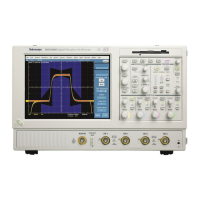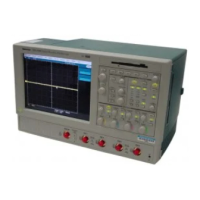TDS5000B Online Programmer Guide
-- 4 9 9 --
MATH<x>:DEFIne
Description
This command allows you to define new waveforms using mathemati-
cal expressions. Sending this command is equivalent to selecting Math
Setup from the Math menu, selecting a math waveform (Math 1
through Math 4 for 4 --channel models or Math 1 through Math 2 for
2--channel models), and then entering a math expression in the
Math<x> box. The query form of this command returns the math defi-
nition for the specified math waveform.
You can specify a math expression from waveforms, measurements and
scalar sources, functions, operands, and numerical constants. You can
define and display up to four math waveforms simultaneously on
4--channel models or up to 2 math waveforms on 2--channel models.
Math expressions can be simple, such as Ch1, which specifies that a
waveform should show the signal source of Channel 1 with no mathe-
matical computation. Math expressions can also be complex, consisting
of 100 plus characters and comprising many sources (including other
math waveforms), functions, and operands. As an example, you can
enter the expression Log(Ch1+Ch2), which specifies that the signals
from channels 1 and 2 are to be algebraically added, and the base 10 log
of the sum is to be shown as the final math waveform.
For more information about constructing mathematical expressions, see
Creating and Using Math Waveforms in the user online help for this
instrument.
Group
Math
Related Commands
MAT H VA R : VAR<x>
Syntax 1
MATH<x>:DEFIne <QString>
Syntax 2
MATH<x>:DEFIne?
Argument
H <QString>
This quoted string argument is the mathematical expression that de-
fines the waveform.
Example 1
MATH2:DEFIne ”Ch1+Ch2”
This command adds the Ch 1 waveform and Ch 2 waveform, storing
the results in Math 2.

